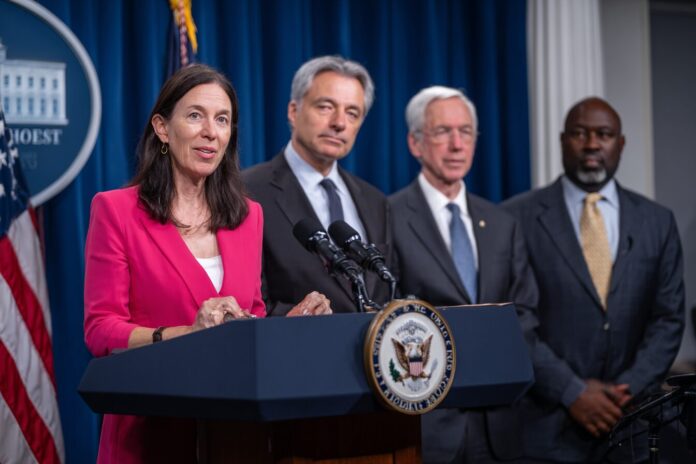Is Deregulation Truly Progress in AI Leadership?
The United States has long been viewed as a leader in technological innovation, and President Trump’s announcement of an AI Action Plan was intended to reinforce that reputation. Most importantly, the administration asserts that deregulation will enable investors and innovators to pursue ambitious projects without bureaucratic delays. Because of this, the plan champions a return to an innovation-first mindset, suggesting that less government interference can spark transformative breakthroughs in artificial intelligence.[source]
However, a closer examination reveals that this approach may well be more of a distraction than a solution. There is genuine concern among experts that by focusing primarily on deregulation, critical issues such as ethical governance, public trust, and global coordination are sidelined. Therefore, the conversation should not only center on deregulation but also on building robust safeguards to ensure that innovation is both sustainable and inclusive.
The Core of Trump’s AI Action Plan
Executive Order 14179, signed on January 23, 2025, paves the way for rapid changes in the regulatory landscape. The order purports to remove impediments to private-sector innovation, aiming to cement US supremacy in artificial intelligence. In addition, the move revokes earlier orders that prioritized safe and trustworthy AI, thereby eliminating long-standing state and federal mandates designed to address issues like bias and discrimination.[source]
Because the plan emphasizes lowering regulatory barriers, it intends to simplify processes for tech companies. Most importantly, by encouraging investment in data infrastructure and energy capacity, the administration claims it can drive growth in the tech sector.[source] Besides that, the strategy includes boosting international competitiveness by prioritizing US-made AI components and investing in workforce development, even though these measures appear superficial compared to the depth of challenges faced today.
What the Plan Leaves Out
Critics argue that the AI Action Plan is more symbolic than substantive. For instance, Public Knowledge sharply criticizes the removal of essential protections designed to combat AI-driven bias and discrimination.[source] Most importantly, the plan overlooks necessary reforms in areas such as market competition, digital equity, and environmental impact, all of which are crucial in a balanced technological advancement plan.
Transitioning from regulation to a more laissez-faire approach, the plan implicitly favors established tech giants already dominant in the market. Because these companies wield significant influence, cutting essential regulations does little to level the playing field for emerging innovators. Therefore, the lack of a comprehensive strategy could allow powerful corporations to consolidate their position further, sidelining smaller entities and undermining fair market practices.
Global Impact and Unilateralism
The strategy’s unilateral approach is another point of contention. Instead of engaging with international stakeholders to develop global AI norms, the plan appears to advocate for an isolated American approach. Consequently, countries with robust frameworks for transparency, climate protection, and digital equity may well reject what they perceive as an imbalanced set of standards.[source]
Because the global community is increasingly emphasizing collaborative governance, a solely domestic focus could diminish America’s credibility on the world stage. Moreover, by prioritizing national interests over global cooperation, this approach risks alienating key allies. Therefore, pursuing leadership through dominance rather than mutual trust could create long-term diplomatic and economic challenges for the United States.
Distraction from Real Solutions
Critics encapsulate the problem neatly: Trump’s AI Action Plan offers deregulation without a clear vision for innovation. Most importantly, while it promises to streamline operations for tech companies, it sidesteps critical issues like safe AI deployment, transparency in algorithmic decision-making, and environmental sustainability. Because the plan offers only modest improvements in AI infrastructure, it fails to address the root causes of systemic challenges within the technology sector.[source]
In addition, the limited focus on workforce development and research investment is concerning. The absence of detailed measures to combat misinformation and safeguard public values further weakens the plan. Therefore, many experts and industry analysts view the policy as a distraction that bypasses the more complex but necessary reforms required to ensure a balanced and ethical AI ecosystem.
What America Needs Instead
If the United States aspires to maintain a leading role in AI innovation, a more thoughtful and comprehensive approach is needed. Most importantly, the country must invest in robust ethical and technical standards that prioritize transparency and accountability. Transitioning from deregulation to proactive regulation can help build trust not only domestically but also among international partners.
Moreover, there is a pressing need to enhance market policies that foster fair competition. By encouraging startups and small tech companies, the government can prevent market monopolization. Because of this, it is vital that policies include incentives for research and innovation alongside real investment in public education and workforce mobility.
Therefore, embracing a dual approach that balances deregulation with strict oversight and ethical frameworks would create a more sustainable and competitive AI ecosystem. Notably, international collaborations could ensure that technology development aligns with global standards and shared values.
Conclusion: Looking Beyond the Distraction
In summary, while Trump’s AI Action Plan is heralded as a bold initiative to secure American dominance, it falls short by neglecting critical areas that demand attention. Most importantly, its focus on deregulation risks undermining efforts to build a safe, accountable, and inclusive AI system. Because true innovation requires both freedom and responsibility, policymakers must broaden their vision.
Transitioning to a balanced strategy that promotes technological advancement while upholding ethical standards is essential. In view of global challenges and rising demands for transparency, only an integrative approach can ultimately secure America’s leadership in AI. For those interested in further discussion, consider reviewing additional perspectives from Health Law Advisor and Politico, which provide further insights into the implications of this controversial policy.



